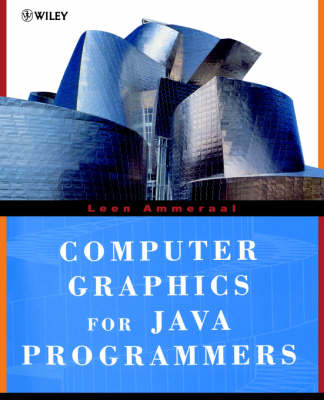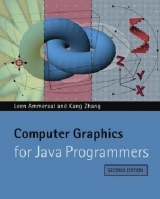
Computer Graphics for Java Programmers
Seiten
1998
John Wiley & Sons Ltd (Verlag)
978-0-471-98142-8 (ISBN)
John Wiley & Sons Ltd (Verlag)
978-0-471-98142-8 (ISBN)
- Titel ist leider vergriffen;
keine Neuauflage - Artikel merken
Zu diesem Artikel existiert eine Nachauflage
Starts by covering elementary concepts, such as how to produce simple graphical objects using logical co-ordinates. The book then progresses to applied geometry and to how to perform rotations and other transformations.
Computer Graphics/CAD Computer Graphics for Java Programmers Leen Ammeraal Many great visual effects can be achieved in computer graphics for which a fundamental understanding of the underlying mathematical concepts - and a knowledge of how they can be implemented in a particular programming language - is essential. Computer Graphics for Java Programmers is a good place to start for those with a little experience of Java who wish to create and manipulate 2D and 3D graphical objects. Two-dimensional subjects discussed include logical coordinates, triangulation of polygons and both Bezier and B-spline curve fitting. There is also a chapter about transformations, culminating in a useful Java class for 3D rotations about an arbitrary axis. The perspective representation of 3D solid objects is discussed in detail, including efficient algorithms for hidden-face and hidden-line elimination. These and many other algorithms are accompanied by complete, ready-to-run Java programs which can be downloaded from the accompanying website.
"Frank Gehry has used computer graphics on several buildings, most notably the new Guggenheim Museum at Bilbao, to create new visual languages and control the design and the cost of production. Starting design with sketches and models, he then used computer graphics to translate the curved fractal forms into exact dimensions which can be used by contractors. This means wastage of steel and stone can be kept to a minimum and the new, curved architecture can be almost the same cost as a repetitive, right angled building. Furthermore, visual refinements and sculptural qualities are reproduced with the fidelity that Gehry seeks. The computer is beginning to show its potential for facilitating creative architecture at the highest level." Charles Jencks, Writer
Computer Graphics/CAD Computer Graphics for Java Programmers Leen Ammeraal Many great visual effects can be achieved in computer graphics for which a fundamental understanding of the underlying mathematical concepts - and a knowledge of how they can be implemented in a particular programming language - is essential. Computer Graphics for Java Programmers is a good place to start for those with a little experience of Java who wish to create and manipulate 2D and 3D graphical objects. Two-dimensional subjects discussed include logical coordinates, triangulation of polygons and both Bezier and B-spline curve fitting. There is also a chapter about transformations, culminating in a useful Java class for 3D rotations about an arbitrary axis. The perspective representation of 3D solid objects is discussed in detail, including efficient algorithms for hidden-face and hidden-line elimination. These and many other algorithms are accompanied by complete, ready-to-run Java programs which can be downloaded from the accompanying website.
"Frank Gehry has used computer graphics on several buildings, most notably the new Guggenheim Museum at Bilbao, to create new visual languages and control the design and the cost of production. Starting design with sketches and models, he then used computer graphics to translate the curved fractal forms into exact dimensions which can be used by contractors. This means wastage of steel and stone can be kept to a minimum and the new, curved architecture can be almost the same cost as a repetitive, right angled building. Furthermore, visual refinements and sculptural qualities are reproduced with the fidelity that Gehry seeks. The computer is beginning to show its potential for facilitating creative architecture at the highest level." Charles Jencks, Writer
Elementary Concepts. Applied Geometry. Rotations and Other Transformations. Some Classic Algorithms. Perspective. Hidden-face Elimination. Hidden-line Elimination. Some Applications. Appendices. Bibliography. Index.
| Erscheint lt. Verlag | 25.2.1998 |
|---|---|
| Reihe/Serie | Worldwide Series in Computer Science |
| Zusatzinfo | bibliography, index |
| Verlagsort | Chichester |
| Sprache | englisch |
| Maße | 188 x 235 mm |
| Gewicht | 640 g |
| Einbandart | Paperback |
| Themenwelt | Mathematik / Informatik ► Informatik ► Grafik / Design |
| Mathematik / Informatik ► Informatik ► Office Programme | |
| Informatik ► Programmiersprachen / -werkzeuge ► Java | |
| Mathematik / Informatik ► Informatik ► Web / Internet | |
| ISBN-10 | 0-471-98142-7 / 0471981427 |
| ISBN-13 | 978-0-471-98142-8 / 9780471981428 |
| Zustand | Neuware |
| Haben Sie eine Frage zum Produkt? |
Mehr entdecken
aus dem Bereich
aus dem Bereich
mit über 150 Workouts in Java und Python
Buch (2023)
Carl Hanser (Verlag)
29,99 €
Einführung, Ausbildung, Praxis
Buch | Hardcover (2023)
Rheinwerk (Verlag)
49,90 €



